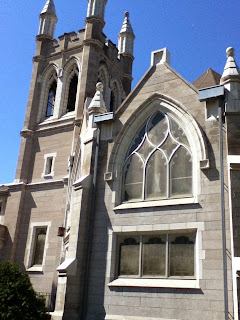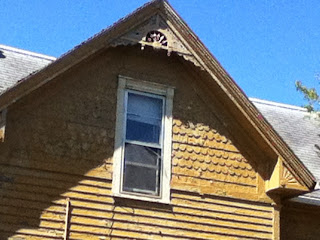The way we lay out our communities can really be evaluated in terms of how well do they do moving us on that continuum from strangers towards friends--REV ERIC O JACOBSEN
The Methodist preacher will offend you not/He's raising money for a parking lot--GARRISON KEILLOR
Save CR Heritage, our local historic preservation organization, held a press conference yesterday morning at Westminster Presbyterian Church to announce the results of complicated negotiations to save a historic house.
The "Frankie House," built in 1896, sits agedly in the way of Westminster's parking lot expansion.
Westminster Church itself was built in 1904, with several additions since.
The deal, which my sources credit to persistent shuttle diplomacy by Beth De Boom and Emily Meyer of Save CR Heritage, starts with Save CR Heritage moving the house--with labor donated by D.W. Zinser Co.--to a lot on 5th Ave SE currently used as a community garden by the Wellington Heights Neighborhood Association. The garden will move to nearby property currently owned by Affordable Housing Network, Inc. Save CR Heritage will renovate and sell the house, and Wellington Heights will have some new neighbors. Pastor Emory Gillespie of Westminster, Wellington Heights Neighborhood Association president Justin Wasson, AHNI executive director Renie Neuberger and Cedar Rapids historian Mark Stoffer-Hunter also described how the arrangement furthered their goals.
My friend John Shaw, who's on the Historic Preservation Commission in Iowa City, describes preservation efforts as one win for every twenty you lose. By that standard, saving the Frankie House is not only a win but well worth celebrating. On top of that, it raises hopes that a similar deal can be worked out to save a nearby neighborhood landmark that reportedly stands in the way of another church's parking expansion.
 | ||
| Habitat for Humanity volunteers work on historic Wellington Heights home (from SaveCRHeritage Facebook page) |
This happy outcome should buy some time for neighborhood residents, institutions and preservationists to think about a long-term strategy for urban neighborhoods. The one sour note yesterday was sounded by Stoffer-Hunter, a brilliant and assiduous historian. He didn't dwell on it, and I don't know if he even intended to be sour, but while discussing the story of the Frankie house's construction (for a local physician whose family included a 4-year-old boy named Frankie) and the original details that survived...
...Stoffer-Hunter noted there is "a lot of great history on this block," including the childhood home of Mamie Doud Eisenhower. Moving the Frankie House preserves this historic home but leaves another "tooth" missing on this historic block.
The mania for flattening neighborhoods into parking lots arises when institutional needs for expansion push into the neighborhoods where they settled years ago. In recent years, Coe College, Mercy Hospital, Physicians Clinic of Iowa, St. Luke's Hospital and St. Paul's United Methodist Church have also expanded their footprint. Now, St. Paul's and Westminster churches are at one end of a two-mile-long parking crater that stretches from Coe to the edge of the New Bohemia district. All this surface parking leaves neighborhoods with missing teeth, struggling neighbors with less connection to economic opportunity, and an overall loss of walkability and vibrancy in the area.
Rev. Eric O. Jacobsen, senior pastor at First Presbyterian Church in Tacoma, Washington, notes that Christians tend not to think about physical environment, thinking that access to cars, high-tech communications, and social groups make location irrelevant. His recent book, The Space Between (cited below), is both an introduction to urbanism aimed at Christians, and a call for Christians to become active in improving the "space between" where they live and where they attend church. When the built environment treats humans with dignity, it improves their lives, their relationships, and their opportunities. Individual civic virtue, and social capital, are framed by Jacobsen as examples of "common grace," blessings from God that may be bestowed upon both Christians and non-Christians.
Faith communities (churches, in the Christian vernacular) have a stake in whether or not the neighborhoods in which they are located are built on a human-scale or for automobiles. Human-scale neighborhoods treat people with dignity and encourage participation in common life. Jacobsen classifies churches as embedded (built in ways that facilitate direct connections with the community that surrounds them) or insular (oriented toward people driving cars). It's not strictly time-based, but embedded churches are typical of traditional neighborhood development, while insular churches reflect the auto-driven development common in America since World War II. Note, particularly if you're not religious and are losing interest, that while Jacobsen focuses on Christian churches, a similar logic could apply to colleges and universities, hospitals, grocery stores, coffeehouses, bars, and even office buildings.
Rev. Gillespie noted yesterday that Westminster made a specific commitment 15 years ago to remain in Wellington Heights. Their outreach includes a Kids Closet and the Loaves and Fishes Food Pantry, both of which surely provide lifelines to individuals on the edge, as well as participation in the Family Promise homeless ministry. But Jacobsen's work suggests institutions can go beyond seeing their neighborhoods only as opportunities for charitable work, but as parishes--places in which they live and which they can help build.
How can institutions engage with each other, and with city government, to make their neighborhoods better places? Jacobsen and the urbanists argue for greater attention to the built environment, particularly the oft-underrated contribution it makes to individual and social life. For a long time, Wellington Heights has been treated as a neighborhood to drive through, rather than as a place where people live--witness the speedways that 2nd and particularly 3rd Avenues have become--though the 2013 passage of a neighborhood plan indicates the city is taking a more positive approach. Can institutions lend their weight to returning Wellington Heights to its historic status as a walkable neighborhood connected to economic opportunity?
The first thing anyone will notice with a parish approach is that expanding surface parking areas doesn't help places. As institutions try to grow, are there alternative approaches to parking issues that are compatible with successful places (particularly for churches who are near their parking capacity about one hour a week at most)? What about encouraging members to park in unused commercial lots or on the street? What about working with the city to institute public transit service on Sundays?
READ MORE AT:
Cindy Hadish, "Save CR Heritage Announces Collaborative Effort to Save Historic Home," Save CR Heritage, 13 May 2015, http://savecrheritage.org/save-cr-heritage-announces-collaborative-effort-to-save-historic-home/
Eric O. Jacobsen, The Space Between: A Christian Engagement with the Built Environment (Baker Academic, 2012)
Rick Smith, "Save CR Heritage Will Save One Itself," Cedar Rapids Gazette, 14 May 2015, 8A










No comments:
Post a Comment